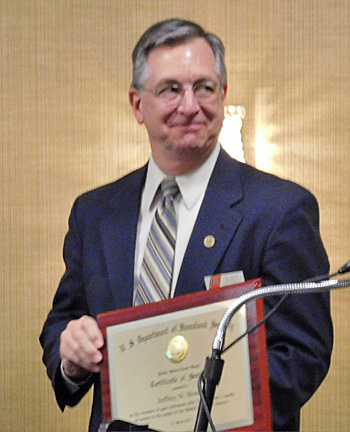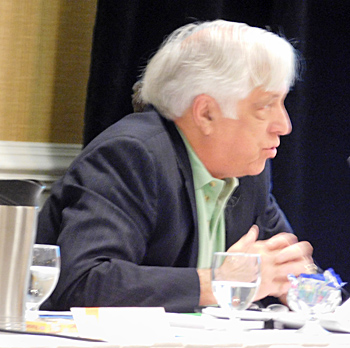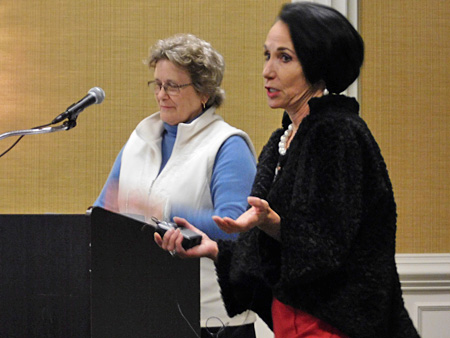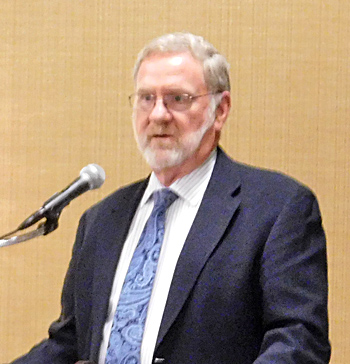U.S. Coast Guard NBSAC97 meeting part 4
U.S. Coast Guard National Boating Safety Advisory Council (NBSAC) 87th meeting in Arlington Virginia March 23-25, 2017. Part 4 of our coverage.
Friday 25 March 2017.
Prevention Through People Subcommittee
He expressed his thanks to Jeff Ludwig, Jeff Hoedt, and Captain Boross.
Streamlining On-Water Instructor Licensing
by Rich Jepson
He presented and there was an engaging conversation about on water boater safety training, sometimes called skills training. Several groups are beginning to or would like to offer on the water boating safety training for boat operators. Existing regulations consider that act carriage for hire, resulting in the person providing the training needing to have higher level commercial vessel operator licenses, a significant number of hours on the sea, a medical physical (somewhat like a pilot), and pass a drug test. These requirements can cost a few thousand dollars and take a lot of time.
Another possible route has been found. A Limited Operator (LOUPV) category might be used by those providing training.
LOUPV = Limited Operator Uninspected Passenger Vessel license.
The Limited Operator licenses must be established and worked out locally. Various local restrictions can be placed upon them such as daylight only, stay out of the sea lanes, stay close to shore, Spring and Summer only, or whatever the local officers deem appropriate.
Mr. Jepson proposes NBSAC work with USCG headquarters to create a guide to help those wishing to provide these services be able to navigate the challenges of obtaining a license to do so.
Captain Gifford asked about age requirements for LOUPV, you must be 18 of older. Several offering on water safety training are though to be under 18.
There was considerable discussion of current regulatory challenges resulting in the inability to create some new category or add a subset within an existing regulation to make what they wanted possible.
Captain Boross said, in 1782 Alexander Hamilton said, It’s our duty to exhibit things as they are, not as they ought to be.
Meaning, we need to work within the existing system. It does us no good to imaging passing some regulation like we would want because we cannot do that at this time. We need to work within the system as it is, not as it ought to be.
Captain Boross thanked Pam Dillon for the article on page 82 of Proceedings about “on water” skills training.
Captain Boross said concerning creating new regulations to make it easier for entities to provide skills training, His office would carry the flag for us, but they can’t carry this one. But he emphasized that trusted entities in specific locations would be given a limited LOUPV.
He noted that model acts, sample laws written by NASBLA, that could be adopted one state at a time are an opportunity.
There was considerable discussion about people thinking this type of training would reduce the number of accidents, but there is not data available to prove that at this time, so the programs cannot be sold to regulators on that basis.
One concern is the poor behavior of some boaters could result in all boaters being banned from certain areas. It is hoped that on water training would result in more boaters being better neighbors on the water.
It was noted that on water training ranked 14th out of 14 in the vote to establish NBSAC priorities at the last meeting.
Captain Gifford thanked Mr. Jepson.
Accident Data Sources: What’s Available to Review and Analyze
He focused specifically on canoes and kayaks, and some on paddleboards in the BADs. (I think he is speaking of the media reports of boating accidents that Coast Guard contractors collect.)
He opened speaking about a recent kayak accident in the Hudson River in which a ferry departing a dock backed over and injured 4 kayakers that were on a guided tour. (it was a 30 August 2016 accident)
If the boating safety people can’t figure out the differences in the types of canoes, kayaks, paddles, and leashes? How is the general public going to do that that’s buying them at Wal-mart, K-Mart, whatever?
On March 16th, two boys were in a one person kayak, another one where the two people perished and the life jackets were found in the boat. They were still looking for one of the bodies after 36 hours.
He found a 2014 database of rescues in Oregon. Some were found dead, some were found alive.
Until we start doing something about these human powered craft, we’re going to continue to have more and more accidents.
He noted most BADs don’t report life jacket wear status. He said some BADs are 7 or 8 pages long in boating season. Most of them are human powered stuff. Half of them survive of more. He counted 10 to 12 years ago and found over 5.000 people just in BADs alone in one year. He did not count whether they survived or died. If all those turned to deaths, we’re not ready for that.
Somebody told him yesterday New Mexico is encapsulating these rescues also. He spoke with someone at NASBLA and there is no database that they have either.
Scott Brewen of Oregon took over to speak about their Search and Rescue database. He apologized for just seeing this yesterday. They will take this data and enter some of it as reportable accidents. The database is basically of when law enforcement goes out to respond to something. Not all of them are reportable accidents.
Oregon is recognizing the impact non-motorized boating is having and they are trying to get their arms around how many are out there and are we seeing accidents and fatalities go up or are accidents and fatalities going up with increased units on the water. The database helps them see what law enforcement is spending time on. Many of these accidents will not wind up in the reportable threshold. They are hoping to get a better idea of the time commitment they are spending with these vessels.
The kayaks on the Hudson was one where we had a guided tour and there were still major injuries in the whole thing.
Chairman Maxim noted these non-powered craft are accounting for an increased proportion of accidents in BARD. He asked for a quick show of hands if this is something we are going to pursue in NBSAC or not. After encouraging everybody to vote, there was a show of interest.
Matt Holder with Free Sup SoCal asked about the last question on the Chairman’s action on should we pursue this, what is actually being pursued?
Chairman Maxim said, some time ago we wrote and an analysis of life jackets. We summarized what the issues were and summarized the relevent literature. We made some recommendations and Richard Moore spoke very eloquently about some of those recommendations. Mr. Maximim is suggesting we put together a packet of factual information and data that summarizes what we know about the problem, what we don’t know about the problem and wish we did and a possible way forward. He is not putting forth a resolution that the Coast Guard should do anything right now, just that BSAC should put together a useful packet of information that probably will be in the form of a report.
NTSB report
Chris Deck now spoke on the three NTSB recommendations to the Coast Guard.
An 83 page NTSB report titled, Shared Waterways:Safety of Recreational and Commercial Vessels in the Marine Transportation System develops the NTSB recommendations.
One recommendation was for USCG to seek statute authority to require all recreational boaters on waters subject to the jurisdiction of the United states to demonstrate they had competed an instructional course or an equivalent that meets NASBLA standards.
A paddleboard representative wanted NBSAC to insert “powerboat” into that proposal.
Jeff Hoedt suggested and NTSB representative be invited to the next meeting to further discuss these recommendations.
Larry Meddok WSIA asked if the committee had any thought had been given to the Universities providing training. He went to school with the director of the training program at San Diego State’s Mission Viejo Aquatic Center. They have to train their instructors almost every year due to high turnover. That process can be burdensome.
Matt Holder of Free Sup SoCal a Paddleboard representative made a public comment after the next presentation that was addressed to this one, so we entered it here. He asked to this body to encourage the Coast Guard to oppose NTSB’s second recommendation (mandatory training). First he thinks this regulatory concept would never see the light of day and Admiral Thomas encouraged this body last October to not press forward regulations that will never see the light of day. Also this regulation does not distinguish between all the different types of operators. He thinks it was sloppy work on their part. Thirdly is this how you would want the Coast Guard spending their time (chasing down people to see their papers)?
Alignment of On-Water Training and Classroom Boating Safety Class Standards
They talked about their work on several training standards, 4 of which have become ANSI standards.
They just completed the 7th public review of the standard for human powered watercraft.
The most recent sailing standard is a descriptive standard rather than a prescriptive standard. Meaning it is outcome based. Those being trained must demonstrate certain things.
ANSI has ten requirements to become a standard.
They talked about trying to harmonize standards for on water and classroom boating safety classes.
The skills standard has been finished and can be seen on OnWaterStandards.org.
Your on water course can be verified three ways:
1. By the provider
2. By the customer
3. By a 3rd party
They talked about Kirkpatrick Measures, a four level model for measuring the effectiveness of training.
The four levels are:
1. Reaction (how the people being trained react to the training).
2. Learning (what have those being trained learned)
3. Behavior (how much did those being trained change their behavior)
4. Results (results of the training)
Richard Moore said he does not like putting funds into skills based training vs. other alternatives or creating false expectations. He does not see much participation in skills training unless it is mandated. States will not require it. Most states would resist the Feds if they mandated it. He expects a positive yield, but not a broad reach without mandates and mandates are extremely unlikely.Jeff Hoedt said that 400 to 500 thousand boaters a year participate in knowledge based training. He has no idea how many participate in skills based training.
Boating Safety Outreach and Non Regulatory Interventions
by Rich Jepson
He passed out 3 X 5 cards and asked us to write down any advice we had for his subcommittee about non-regulatory interventions.
Jim Emmons of WSIA suggested “Outreach” might limit our thoughts to as means to accomplish our purposes. Mr. Jepson said he was open to other words in that slot but none were suggested at that time.
New Business and Public Comment on Prevention Through People
Pete Chisholm showed a brief video that shows why we are on NBSAC. It included some boat show photos from years ago where no one wore life jackets on boats in the water vs. now when life jackets are ubiquitously worn on boats in the water at boat shows.

Phil Hoedt receiving an award from his supervisors for his excellent work at the USCG Office of Boating Safety at NBSAC97
The Strategic Planning Subcommittee just got underway and Captain Boross apologized for interrupting them.
Jeff Hoedt was presented two awards. A plaque by his superiors and a ship’s bell plaque by his staff.
PropellerSafety.com comment – we would add our best wishes to Mr. Hoedt in his retirement as well. He was a pleasure to work with. To borrow a phrase from Captain Boross, Jeff Hoedt did a great job of listening to all the equities involved.
When we forwarded some bit of information to him, we typically received a prompt response. He often distributed materials we sent him about specific accidents, specific types of accidents, or propeller safety devices to others at USCG.
We also thank him for his many interactions with Marion at SPIN and always being willing to listen to her.
While at the meeting, I had the opportunity to meet Jeff Hoedt’s wife. As one might expect, she is a great woman.
Strategic Planning Subcommittee
Results of Issues Prioritization Survey
by Harry Hogan
Harry Hogan presented the results and a statistical analysis of the data.
The basic finding is NBSAC rated priorities in this order:
- Learn more about human factors
- Increase life jacket wear
- Alternatives to regulation
- Learn more about paddlecraft
- Improve outreach activities
- Change focus of boating safety courses
- Improvements to National Survey
- Improve analytic techniques
- Increase Boating Survey focus on small boats
- Improve ways to correct for underreporting
- Improve BARD
- Optimize grant program
- Simplify licensing process of On-Water Instructors
- Portals for increased access of survey and BARD data
Several Coast Guard folks took the same survey and ranking their first five like this:
- Improve outreach activities
- Learn more about paddlecraft
- Increase life jacket wear
- Improve ways to correct for underreporting
- Learn more about human factors
- Change focus of boating safety courses
- Alternatives to regulation
There was considerable discussion about the variability of rankings withing NBSAC and their lack direct obvious correlation with USCG’s priorities per the survey. However both groups did reasonably agree on which items should be in the top half.
There was discussion of voting again, voting within the top half and other ideas. In the end, the priorities were left the way they were in the vote.
Strategic Planning Initiatives Reports
Each of the three groups reported.
Initiative 1. Education, training, outreach
Initiative 2. Leverage, enforce, policies, regulations, standards
Initiative 3. Research and Development
Initiative 1. Education, training, outreach Report
by Vann Burgess
He talked about measuring and setting targets.
By following an evidence based approach, we first analyze surveillance data, better define the problem, identify possible strategies, align strategies with CoAs, and set targets. This path also leads to operationalizing the plan.
There was some discussion about what a strategic plan was. This one started out as what new things should we be doing, and did not include what things we are doing we feel we should continue to do.
In order to make sure existing good things to do not get overlooked, a track was inserted for the existing things.
The Kirkpartick Mode was discussed as a means of evaluating outreach efforts. The Kirkpatrick Model is a pyramid with Results at the top, then on successive layers: Behavior, Learning, and Reaction.
He said we could add one more step to the model, Return on Investment.
Initiative 2. Policies, Regulations, and Standards
by Phil Cappel USCG
They studied 5 years of collision data and identified 12 locations with >20 collisions.
They also reached out to the BLAs in these same areas.
The Colorado River near Bullhead City Arizona and Laughlin Nevada (these areas are across the river from each other) had 94 collisions in 5 years. Most of them involve Navigation Rules (Nav Rules) violations.
They are looking at using this area as a test bed for ways to reduce collisions through outreach and other programs.
Initiative 3. Research and Development
presented by Don Kerlin USCG
They are working toward 100 percent completeness and accuracy and timely submission of BARD reports by 2021.
They will ensure the maintenance of ongoing activities such as BARD updates and the annual Boating Statistics publication.
They are discussing what data should be public, and how to access the data. He talked about the possible use of dashboards to access the data.
PropellerSafety.com note – while the notes above speak primarily about accident data, they are talking in a much broader scale about all kinds of data that could be useful in USCG recreational boating safety decision processes (like the hours of use studies, life jacket wear studies, etc.)
Why Does NBSAC do a Strategic Plan?
There was a question from the Council about why does NBSAC create a strategic plan for USCG. Shouldn’t USCG create their own. After some discussion, Captain Boross said, it is the law. Everything they (USCG) does is in accordance with FACA laws (Federal Advisory Committee Act) requiring them to conduct these convenings. He thanked them, especially the public and the equities.
He said it is a statutory requirement that the group create this plan.
END of part 4 of our coverage
Links to the meeting agenda and all 5 parts of our NBSAC97 coverage are below.







